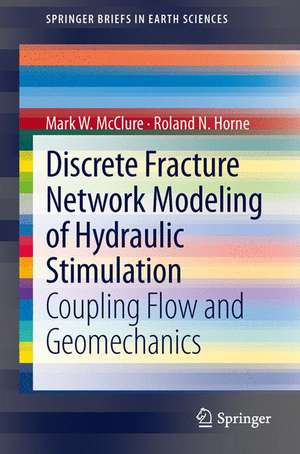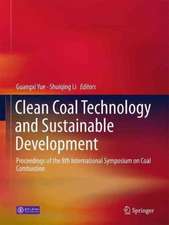Discrete Fracture Network Modeling of Hydraulic Stimulation: Coupling Flow and Geomechanics: SpringerBriefs in Earth Sciences
Autor Mark W. McClure, Roland N. Horneen Limba Engleză Paperback – 9 iul 2013
Din seria SpringerBriefs in Earth Sciences
-
 Preț: 380.25 lei
Preț: 380.25 lei -
 Preț: 378.12 lei
Preț: 378.12 lei -
 Preț: 290.09 lei
Preț: 290.09 lei -
 Preț: 477.72 lei
Preț: 477.72 lei -
 Preț: 381.98 lei
Preț: 381.98 lei -
 Preț: 355.07 lei
Preț: 355.07 lei -
 Preț: 355.37 lei
Preț: 355.37 lei -
 Preț: 351.90 lei
Preț: 351.90 lei -
 Preț: 381.21 lei
Preț: 381.21 lei -
 Preț: 377.35 lei
Preț: 377.35 lei -
 Preț: 342.44 lei
Preț: 342.44 lei -
 Preț: 343.98 lei
Preț: 343.98 lei - 20%
 Preț: 389.07 lei
Preț: 389.07 lei -
 Preț: 378.92 lei
Preț: 378.92 lei -
 Preț: 375.62 lei
Preț: 375.62 lei -
 Preț: 379.68 lei
Preț: 379.68 lei -
 Preț: 378.12 lei
Preț: 378.12 lei -
 Preț: 443.75 lei
Preț: 443.75 lei -
 Preț: 378.54 lei
Preț: 378.54 lei -
 Preț: 380.07 lei
Preț: 380.07 lei -
 Preț: 376.96 lei
Preț: 376.96 lei -
 Preț: 379.09 lei
Preț: 379.09 lei - 15%
 Preț: 464.18 lei
Preț: 464.18 lei -
 Preț: 376.96 lei
Preț: 376.96 lei -
 Preț: 348.01 lei
Preț: 348.01 lei -
 Preț: 379.48 lei
Preț: 379.48 lei -
 Preț: 375.07 lei
Preț: 375.07 lei -
 Preț: 477.94 lei
Preț: 477.94 lei -
 Preț: 376.22 lei
Preț: 376.22 lei -
 Preț: 349.41 lei
Preț: 349.41 lei -
 Preț: 381.00 lei
Preț: 381.00 lei - 15%
 Preț: 463.35 lei
Preț: 463.35 lei -
 Preț: 376.22 lei
Preț: 376.22 lei -
 Preț: 376.96 lei
Preț: 376.96 lei -
 Preț: 446.47 lei
Preț: 446.47 lei -
 Preț: 346.62 lei
Preț: 346.62 lei -
 Preț: 379.68 lei
Preț: 379.68 lei -
 Preț: 373.32 lei
Preț: 373.32 lei -
 Preț: 377.95 lei
Preț: 377.95 lei -
 Preț: 377.57 lei
Preț: 377.57 lei -
 Preț: 390.82 lei
Preț: 390.82 lei -
 Preț: 375.45 lei
Preț: 375.45 lei -
 Preț: 377.73 lei
Preț: 377.73 lei -
 Preț: 376.04 lei
Preț: 376.04 lei -
 Preț: 377.18 lei
Preț: 377.18 lei -
 Preț: 379.09 lei
Preț: 379.09 lei
Preț: 377.18 lei
Nou
Puncte Express: 566
Preț estimativ în valută:
72.17€ • 75.51$ • 59.95£
72.17€ • 75.51$ • 59.95£
Carte tipărită la comandă
Livrare economică 03-17 aprilie
Preluare comenzi: 021 569.72.76
Specificații
ISBN-13: 9783319003825
ISBN-10: 3319003828
Pagini: 100
Ilustrații: X, 90 p. 42 illus., 41 illus. in color.
Dimensiuni: 155 x 235 x 5 mm
Greutate: 0.16 kg
Ediția:2013
Editura: Springer International Publishing
Colecția Springer
Seria SpringerBriefs in Earth Sciences
Locul publicării:Cham, Switzerland
ISBN-10: 3319003828
Pagini: 100
Ilustrații: X, 90 p. 42 illus., 41 illus. in color.
Dimensiuni: 155 x 235 x 5 mm
Greutate: 0.16 kg
Ediția:2013
Editura: Springer International Publishing
Colecția Springer
Seria SpringerBriefs in Earth Sciences
Locul publicării:Cham, Switzerland
Public țintă
ResearchCuprins
Introduction.-Discrete Fracture Network Modeling.-Review of Stimulation Models.- References.-Methodology.- Governing and Constitutive Equations.- Initial Conditions.- Methods of Solution.- Spatial Domain.- Special Stimulation Topics.-References.-Results.- Simulation and Discretization Details.- Model A: Small Test Problem.- Models B and C: Large Test Problems.- Model D: Testing the Strain Penalty Method.- Hierarchical Matrix Decomposition.-References.- Discussion.- Model A.- Model B.- Model C.- Model D.- Hierarchical Matrix Decomposition.- Extension of the Model to Three Dimensions.-References.-Conclusions.
Notă biografică
Mark McClure is Assistant Professor in the Department of Petroleum and Geosystems Engineering at University of Texas, Austin. He is winner of the Hank Ramey Award for Outstanding Research and Service to the Department of Energy Resources Engineering in 2012 at Stanford. His article, "Investigation of Injection-Induced Seismicity using a Coupled Fluid Flow and Rate and State Friction Model" published in Geophysics, won best paper from the Society of Exploration Geologists in 2011. Roland N. Horne is the Thomas Davies Barrow Professor of Earth Sciences at Stanford University, and was the Chairman of the Department of Petroleum Engineering from 1995 to 2006. He holds BE, PhD and DSc degrees from the University of Auckland, New Zealand, all in Engineering Science. Horne has been an SPE Distinguished Lecturer, and has been awarded the SPE Distinguished Achievement Award for Petroleum Engineering Faculty, the Lester C. Uren Award, and the John Franklin Carl Award. Horne is a member of the U.S. National Academy of Engineering and is also an SPE Honorary Member. He is also 2010-2013 President of the International Geothermal Association.
Textul de pe ultima copertă
Discrete Fracture Network Modeling of Hydraulic Stimulation describes the development and testing of a model that couples fluid-flow, deformation, friction weakening, and permeability evolution in large, complex two-dimensional discrete fracture networks. The model can be used to explore the behavior of hydraulic stimulation in settings where matrix permeability is low and preexisting fractures play an important role, such as Enhanced Geothermal Systems and gas shale. Used also to describe pure shear stimulation, mixed-mechanism stimulation, or pure opening-mode stimulation. A variety of novel techniques to ensure efficiency and realistic model behavior are implemented, and tested. The simulation methodology can also be used as an efficient method for directly solving quasistatic fracture contact problems. Results show how stresses induced by fracture deformation during stimulation directly impact the mechanism of propagation and the resulting fracture network.
Caracteristici
An entirely new model that is a significant technical advance in the field Fully calculates stresses due to deformation in large, complex discrete fracture networks, which has not been demonstrated by anyone else in the literature Includes supplementary material: sn.pub/extras



















